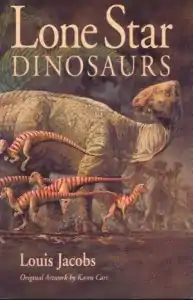Lone Star Dinosaurs
Lone Star Dinosaurs is a book written by Louis L. Jacobs and published in 1995. It concerns the history of dinosaurs in Texas and the people who found their remains. Most of the dinosaurs in the book are from the Cretaceous age and a few of the dinosaurs include Pleurocoelus, Alamosaurus, Tenontosaurus, Tyrannosaurus rex, and the pterosaur Quetzalcoatlus. The stories within the book were compiled directly from the people who found the fossils.
 Cover for Lone Star Dinosaurs | |
| Author | Louis L. Jacobs |
|---|---|
| Illustrator | Karen Carr |
| Genre | Non-fiction |
| Publisher | Ivan R. Dee |
Publication date | 1995 |
| Media type | Print (Hardcover & paperback) |
| ISBN | 0-613-28934-X |
The book's subject material was used as the basis for an exhibit opened on November 3, 1995 at the Fort Worth Museum of Science and History. The exhibit included paintings, bones exhumed from Texas, and interactive video components.[1]
Content
The book begins by discussing the history of paleontology in Texas and several of the more renowned academic researchers in the field, including Robert T. Hill. The various types of dinosaurs discovered in the Texas strata, along with a more general look at paleontological finds around the world. This chapter is followed by three others that each focus on a different period of evolutionary history for Texas dinosaurs.[2]
The first is during the late Triassic period where early forms of well known dinosaur species were just beginning to evolve and whose fossils were uncovered in the Texas Dockum Formation. The second history chapter covers the middle Cretaceous period that had fossils found in the Paluxy Formation, the Glen Rose Formation, and the Twin Mountains Formation. Lastly, the third and final chapter covering the history of Texas fossil discoveries moves to the late Cretaceous and the more reptilian finds at the Aguja Formation and the Javelina Formation.[3]
Style and tone
For The Quarterly Review of Biology, Edwin H. Colbert notes the "felicitous prose style" of the book that has "excellent descriptions" that are "abundant illustrated by the very skillful and imaginative paintings of Karen Carr".[3] Robert Burnham for Earth magazine stated that Jacobs "is a marvelous raconteur, sweeping the reader along in a comfortable, amiable way".[2] A review in Choice by D. Bardack said that Jacobs uses a "conversational style" that helps to get across the "salient points of anatomy" that relate to dinosaur evolutionary history.[4]
Critical reception
Judyth Rigler of the San Antonio Express-News called it a "visually stunning novel".[5] In the journal Nature, Douglas Palmer described the book as a "homely American family tale of hard work and togetherness in the search for and discovery of dinosaurs", though he lamented that children in the United Kingdom won't have the opportunities for such fossilized exploration.[6]
See also
References
- Baker, Anita (October 29, 1995). "Texas Scholars Dig In for Dinosaurs". Tulsa World. Retrieved December 7, 2020.
- Burnham, Robert (April 1997). "Dinos, y'all". Earth. Kalmbach Publishing. 6 (2): 68. ISSN 1056-148X. Retrieved December 9, 2020.
- Colbert EH (June 1997). "Review: Lone Star Dinosaurs". The Quarterly Review of Biology. 72 (2): 192–193. JSTOR 3036345. Retrieved December 8, 2020.
- Bardack, D. (March 1996). "Review: Lone Star Dinosaurs". CHOICE: Current Reviews for Academic Libraries. Association of College and Research Libraries. 33 (7): 1165. ISSN 0009-4978. Retrieved January 19, 2021.
- Rigler, Judyth (October 22, 1995). "Takeoff trivia includes dinos". San Antonio Express-News. Retrieved June 4, 2011.
- Palmer D (November 16, 1995). "Fossils for the next generation". Nature. 378 (6554): 317. doi:10.1038/378317b0. Retrieved December 8, 2020.